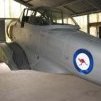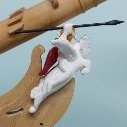MORE HANDBOOKS ARE ON THEIR WAY! We will let you know when they get here.
×
-
Posts
885 -
Joined
-
Last visited
Reputation Activity
-
 Julie Mo got a reaction from PeteB in Endeavour 1934 by Julie Mo - Amati - Scale 1:35 - America's Cup UK J-Class Challenger
Julie Mo got a reaction from PeteB in Endeavour 1934 by Julie Mo - Amati - Scale 1:35 - America's Cup UK J-Class Challenger
Bill, while I am happy to end this crazy chapter, I feel overwhelmed by what is awaiting us. 30 or 40 years ago, I would have relished the opportunity, but I have found a very nice peace in model building. I'm not sure I want to tackle another house. But I will...
My therapist, the Endeavour, called me into session again. The farther I get into the build, the more I enjoy it. My therapist, Endeavour, told me I had to take a picture of the real heroes, the ones that make this so much fun.
The tools in the photo are the heroes. They are the tools I used most often to get where I am with this build, It's coming together nicely.
What this venture has reminded me of is when I first started woodworking. I bought crappy tools and had a crappy experience. In time, I walked away. For years. Working with the wrong tools was frustrating and time consuming. But I knew there was something I was missing. Others did it. Why can't I? In the end I realized the problem was crappy tools.
I'm still working with only hand tools now, but at least they aren't made by Hasbro.
-
 Julie Mo got a reaction from Eddie in Endeavour 1934 by Julie Mo - Amati - Scale 1:35 - America's Cup UK J-Class Challenger
Julie Mo got a reaction from Eddie in Endeavour 1934 by Julie Mo - Amati - Scale 1:35 - America's Cup UK J-Class Challenger
I never thought it would take so long to get the shop set up. But I am just now coming to that point when I can move about and get things done.
It will still be a while before I can devote any serious time to the build but I am happy to report I have her in a place she won't be forgotten.
I have great plans for her.
-

-
 Julie Mo got a reaction from mrjimmy in Harbor Freight Mini Wood Planes
Julie Mo got a reaction from mrjimmy in Harbor Freight Mini Wood Planes
Toolaholic's confession: I bought a honing guide because I knew I needed it. But it didn't work out like I had hoped. Then I bought a better and, rather sophisticated, honing system. It worked great for plane irons and chisels that needed a lot of work. But using it was somewhat time consuming and I waited until my tools showed dulling before I took them to the "honing table".
Somewhere along the way, I learned it is better, and easier, to keep your tools well honed. All sharp tools dull with use. Take a few minutes to hone the edge before and after use. I rarely use guides anymore.
Rob Cosman does a great job explaining the free hand sharpening process. I don't use his angle tool. What I do is rock the primary bevel until it sits flush on the stone, then lift a bit for the secondary bevel.
-
 Julie Mo got a reaction from AON in Harbor Freight Mini Wood Planes
Julie Mo got a reaction from AON in Harbor Freight Mini Wood Planes
Toolaholic's confession: I bought a honing guide because I knew I needed it. But it didn't work out like I had hoped. Then I bought a better and, rather sophisticated, honing system. It worked great for plane irons and chisels that needed a lot of work. But using it was somewhat time consuming and I waited until my tools showed dulling before I took them to the "honing table".
Somewhere along the way, I learned it is better, and easier, to keep your tools well honed. All sharp tools dull with use. Take a few minutes to hone the edge before and after use. I rarely use guides anymore.
Rob Cosman does a great job explaining the free hand sharpening process. I don't use his angle tool. What I do is rock the primary bevel until it sits flush on the stone, then lift a bit for the secondary bevel.
-
 Julie Mo got a reaction from Eddie in Endeavour 1934 by Julie Mo - Amati - Scale 1:35 - America's Cup UK J-Class Challenger
Julie Mo got a reaction from Eddie in Endeavour 1934 by Julie Mo - Amati - Scale 1:35 - America's Cup UK J-Class Challenger
Rasps are a bit of a hit and miss. The machine made rasps frustrated me. I have a couple of Nicholson rasps that were a waste of money, for me anyway. Some people are OK about working with them but I'm not in that group. When I got into building solid body guitars, I bit the bullet and bought a couple of Auriou rasps. It hurts once, then you enjoy them for life. They are hand stitched and simply a joy to work with. They are locked up so I bought an Iwasaki rasp for this build. It was better than the Nicholson but I missed my Auriou rasps.
After the longing for those rasps got the better of me, I bought a couple more. I closed my eyes at the price once again and hit the order button. Liogier is said to make equally good rasps but I have never used one. They are a little harder to get in the US.
If you want to see how the Auriou are made...
-
 Julie Mo got a reaction from Retired guy in Endeavour 1934 by Julie Mo - Amati - Scale 1:35 - America's Cup UK J-Class Challenger
Julie Mo got a reaction from Retired guy in Endeavour 1934 by Julie Mo - Amati - Scale 1:35 - America's Cup UK J-Class Challenger
I managed to get the nose back into alignment. Then I applied CA glue in the joints and hit it with an accelerator.
I come back this morning and check it against a straight edge and this is what I see:
The tip of the bow bent a bit too far the other way. Maybe I missed it or maybe the wood swelled after gluing.
If you look at the mid-section beam on top of the straight edge, you can see a slight dip down as it runs toward the bow. When I was assembling the skeleton I noticed the plywood wasn't perfectly straight but I hoped once it was all together they would straighten. Before I began installing the backing, it looked pretty straight, but not perfect. I couldn't do anything to make it perfect.
This is to show how I made the nose adjustments.
-
 Julie Mo got a reaction from Canute in Reading Boat Drawings
Julie Mo got a reaction from Canute in Reading Boat Drawings
I downloaded the FREE!Ship program and loaded it in today. I opened a new project and inserted the numbers I had from the Endeavour II drawing. When the new project opened, here's what I saw:
Maybe that 14' draught number wasn't supposed to include the keel.
-
 Julie Mo got a reaction from Canute in Reading Boat Drawings
Julie Mo got a reaction from Canute in Reading Boat Drawings
A couple of years ago I bought Understanding Boat Design by Ted Brewer and The Elements of Boat Strength: For Builders, Designers and Owners by Dave Gerr. The latter was pretty intense and, with the little knowledge I had, was more than I cared to tackle at the time. Now I'm anxious to find it after the movers arrive.
I worked in the building trades for 35 years and at the end of my career I was taking engineered electrical drawings and redrawing them into construction-ready plans. That's when I taught myself AutoCAD. I took to it like a child to Disney World. Definitely some of my best years in the trades.
I saw the Skeen book on Amazon. They grouped it with two other books as a "Frequently Bought Together" - the two books I mentioned above. So maybe I'm on the right book learning track. BTW, I ordered Skeen.
Julie
-
 Julie Mo got a reaction from Canute in Reading Boat Drawings
Julie Mo got a reaction from Canute in Reading Boat Drawings
Thank you, Bob. While I won't lie and say I absorbed everything you said, I will say it helps me get a better understanding about how a boat design comes into fruition.
I find myself surprised that something I intended to be a woodworking project to keep me busy during a house hunt (the kit build) has become a door that opened to something I have been interested in for decades.
-
 Julie Mo got a reaction from Canute in Reading Boat Drawings
Julie Mo got a reaction from Canute in Reading Boat Drawings
I finished the half-breadth lines, mirrored them and put them in place. Working in a wireframe like this gets more difficult as you add to it. You have to be very careful you are snapping to the proper place. Yes, I goofed some of it up.
This is an image looking up from the bottom:
On the left is the composite of everything I have added to the 3D wireframe. Middle and right are the body lines I used to make the frames.
I still have to rework the keel area if I want this done right. I also noticed the half-breadth lines weren't drawn in at every level line.
If I am to complete the 3D image, I will need to figure out how to draw a 3D half-breadth outline that will allow for all three x, y and z coordinates. So far, all I have been able to do is two planes in any kind of line. AutoCAD won't allow something like a polyline to run through three planes.
-
 Julie Mo got a reaction from Canute in Reading Boat Drawings
Julie Mo got a reaction from Canute in Reading Boat Drawings
Bob, when redrawing, do you go with what looks good? Or do you follow something more precise?
I'm going to draw over the buttock lines next and insert them in place. I realize I won't have anything that replicates the sheer at the rail but maybe the level lines will provide some guidance. Whatever the case, I am enjoying this. I've been drawing boats since I was in grade school but I never had a clue how to do anything close to design.
-
 Julie Mo got a reaction from Canute in Reading Boat Drawings
Julie Mo got a reaction from Canute in Reading Boat Drawings
Thank you for the replies. I absorbing everything like a sponge.
I started taking the body lines and making full frames.
After rotating them into their 3D position, I placed the front frame lines in their respective locations.
Working from the inside toward the outside, I placed the frame lines at each point along the hull. I made an operator error that isn't so evident in this picture but I was able to fix it without a lot of trouble.
Next I placed the back half of the frame lines in position and moved them from stern to midships working inside to out.
As you can see, the back half didn't come out as well, relative to the keel line. If I moved the frames so they better line up with the keel line, the width of each frame line doesn't fair properly from one frame to the next and on from there. As it is in the picture above, they do. Since I was unable to decipher the frame numbers on the PDF, I just placed them according to their position on the body line drawing.
I was pretty exact when creating the body lines but the lines were a blur when zooming in close. And at the keel section, it was hard to tell if any of the lines crossed over one another. Some just melted into each other.
This is just an exercise to help me understand boat design and see how I fare. It's keeping me busy as we approach moving day. I doubt I'll ever use this for a scratch build but it's nice to use it as a learning experience.
-
 Julie Mo got a reaction from cristikc in IF YOU HAD A CHOICE
Julie Mo got a reaction from cristikc in IF YOU HAD A CHOICE
Greg, if you already have a drill press, check this out. It's also sold at Stew-Mac, the same place that sells the 6" thin kerf circular saw blade. It's designed as a thickness sander and works pretty well. I'm finding a number of luthier tools cross over well into model making.
-
 Julie Mo got a reaction from Archi in Sovereign of the Seas kit (was there ever more than one)
Julie Mo got a reaction from Archi in Sovereign of the Seas kit (was there ever more than one)
Here's the 58" version, Mike. Here's the 43" kit.
The 58" version finished:
What do you think, maybe a weekend to build?
-
 Julie Mo got a reaction from src in IF YOU HAD A CHOICE
Julie Mo got a reaction from src in IF YOU HAD A CHOICE
Greg, if you already have a drill press, check this out. It's also sold at Stew-Mac, the same place that sells the 6" thin kerf circular saw blade. It's designed as a thickness sander and works pretty well. I'm finding a number of luthier tools cross over well into model making.
-
 Julie Mo reacted to JohnE in Reading Boat Drawings
Julie Mo reacted to JohnE in Reading Boat Drawings
Hi Julie.
I think FreeShip looks at body stuff. Keels are appendages.
Ciao, John
-
 Julie Mo got a reaction from mtaylor in Reading Boat Drawings
Julie Mo got a reaction from mtaylor in Reading Boat Drawings
I downloaded the FREE!Ship program and loaded it in today. I opened a new project and inserted the numbers I had from the Endeavour II drawing. When the new project opened, here's what I saw:
Maybe that 14' draught number wasn't supposed to include the keel.
-
 Julie Mo reacted to nancysqueaks in Reading Boat Drawings
Julie Mo reacted to nancysqueaks in Reading Boat Drawings
Julie, rather blown away by these posts, in fact rather in awe...
It is nice to be good at something and still ask questions,
that in my book is great, and really the way to learn.
Good luck, Cheers, Nick
-
 Julie Mo got a reaction from mtaylor in Reading Boat Drawings
Julie Mo got a reaction from mtaylor in Reading Boat Drawings
A couple of years ago I bought Understanding Boat Design by Ted Brewer and The Elements of Boat Strength: For Builders, Designers and Owners by Dave Gerr. The latter was pretty intense and, with the little knowledge I had, was more than I cared to tackle at the time. Now I'm anxious to find it after the movers arrive.
I worked in the building trades for 35 years and at the end of my career I was taking engineered electrical drawings and redrawing them into construction-ready plans. That's when I taught myself AutoCAD. I took to it like a child to Disney World. Definitely some of my best years in the trades.
I saw the Skeen book on Amazon. They grouped it with two other books as a "Frequently Bought Together" - the two books I mentioned above. So maybe I'm on the right book learning track. BTW, I ordered Skeen.
Julie
-
 Julie Mo got a reaction from mtaylor in Reading Boat Drawings
Julie Mo got a reaction from mtaylor in Reading Boat Drawings
Thank you, Bob. While I won't lie and say I absorbed everything you said, I will say it helps me get a better understanding about how a boat design comes into fruition.
I find myself surprised that something I intended to be a woodworking project to keep me busy during a house hunt (the kit build) has become a door that opened to something I have been interested in for decades.
-
 Julie Mo got a reaction from mtaylor in Reading Boat Drawings
Julie Mo got a reaction from mtaylor in Reading Boat Drawings
I finished the half-breadth lines, mirrored them and put them in place. Working in a wireframe like this gets more difficult as you add to it. You have to be very careful you are snapping to the proper place. Yes, I goofed some of it up.
This is an image looking up from the bottom:
On the left is the composite of everything I have added to the 3D wireframe. Middle and right are the body lines I used to make the frames.
I still have to rework the keel area if I want this done right. I also noticed the half-breadth lines weren't drawn in at every level line.
If I am to complete the 3D image, I will need to figure out how to draw a 3D half-breadth outline that will allow for all three x, y and z coordinates. So far, all I have been able to do is two planes in any kind of line. AutoCAD won't allow something like a polyline to run through three planes.
-
 Julie Mo got a reaction from captainbob in Reading Boat Drawings
Julie Mo got a reaction from captainbob in Reading Boat Drawings
A couple of years ago I bought Understanding Boat Design by Ted Brewer and The Elements of Boat Strength: For Builders, Designers and Owners by Dave Gerr. The latter was pretty intense and, with the little knowledge I had, was more than I cared to tackle at the time. Now I'm anxious to find it after the movers arrive.
I worked in the building trades for 35 years and at the end of my career I was taking engineered electrical drawings and redrawing them into construction-ready plans. That's when I taught myself AutoCAD. I took to it like a child to Disney World. Definitely some of my best years in the trades.
I saw the Skeen book on Amazon. They grouped it with two other books as a "Frequently Bought Together" - the two books I mentioned above. So maybe I'm on the right book learning track. BTW, I ordered Skeen.
Julie
-
 Julie Mo reacted to JohnE in Frégate d'18 par Sané , la Cornélie
Julie Mo reacted to JohnE in Frégate d'18 par Sané , la Cornélie
Getting a good body plan is an interesting process. The French used diagonals a lot. They were the ribbands (lisses) that banded the ship and defined the shapes of the intermediate (filler) frames between the stations. The drawing shows straight lines, but that was only for a particular station (in this case, the forward master couple); the diagonal for next station would start at the same centerline mark, but terminate in an entirely different place.
So the diagonals aren’t really diagonal; they are ribbands having compound curvature in two dimensions. Fortunately, the French defined the termination points of each ribband (lisse), for each station, in tables of offsets with a master table giving end point termination of each on the vertical planes of the bow and stern with respect to the centerline.
This is really cool, because one can get a tracing of the body plan from a draught, and then plot the ribband terminations for each station against the tracing of the station. This allows for rational adjustments to the traced curve, to fit the “waypoints” defined by the tabular data. Don’t ya just love CAD and beziers.
What’s even nicer is that the collection of termination points plot into a very useful half-breadth, when stood on end and rotated. So there’s going to be a couple of half-breadths; one with traditional horizontal waterlines, another from the ‘lisses’. I will, perhaps, have to include the tabular data in the plan set, so things make more solid sense.
[edit] Oops, was reminded that I have to do two profile plans; one with the lines of the lisses, and another one with traditional buttock-bows. My choice. This is becoming a frégate de 18 par Monsieur LaDrague (a shameless pun on my name, but it sounds fun, doesn't it?) Oh, well ...
John
-
 Julie Mo reacted to JohnE in Frégate d'18 par Sané , la Cornélie
Julie Mo reacted to JohnE in Frégate d'18 par Sané , la Cornélie
Progress. Timbering of the head. The cutwater (gorgere) and gammon knee (courbe capucine de l’eperon) are derived from the Virginie draught. The other individual timbers are speculative and not strictly specific to any particular vessel. However the main pieces follow Vial and their particular arrangement follows Boudriot and Delacroix and what seems to be standard practice at the Brest yards. Position of the gammoning slots is also speculative.
The ensemble of the head (l’Eperon) is not quite as long and elegant as in Boudriot’s Venus, but neither is it as short and spiky sharp as the Rochefort plans of Justice. Boudriot gives the steeve of Venus’ bowsprit as 33 degrees; The steeve of Justice is 28 degrees from the Rochefort draughts. I am arbitrarily giving Cornélie a steeve of 29 degrees, but that may well go to 30.
The flow of the ensemble is taken from the Eyeball, Corrective Lens Assisted, Mk-I. It’s subject to a bit of tweaking once the cheeks and the rest of the decorative pieces, including the carving of Cornelia, get dialed in.
Still doing detail work on the apron and rising wood. Have to loft the frames first, because this is an iterative process. So detailing the contre- étrave/apron and rising wood will have to wait a bit.
John










